And the Dog Has His Day
Why dogs are the new darlings of cognitive science

Kay Hinton
This will be his earliest memory. Red light, morning light. High ceiling canted overhead. Lazy click of toenails on wood. Between the honey-colored slats of the crib a whiskery muzzle slides forward until its cheeks pull back and a row of dainty teeth bare themselves in a ridiculous grin.
So begins the bond between Edgar Sawtelle and Almondine, the dog who, he will later say, “bore his soul.” As Edgar—title character of The Story of Edgar Sawtelle, the best-selling 2008 novel by David Wroblewski—grows up, surrounded by the remarkable dogs his family breeds, raises, and trains, Almondine is not merely his constant companion; she is his family, his soulmate, his deepest and most enduring love.
Canine characters abound in literature, from the loyal Old Yeller, Sounder, and Old Dan and Little Ann of tearjerking young-adult classics to Jack London’s Buck, Charles Dickens’s Jip, and eloquent Enzo, narrator of the more recent The Art of Racing in the Rain. But Wroblewski’s debut novel is an exceptionally thorough testament to all that is extraordinary about dogs: their fine emotional intelligence, their desire and ability to serve humans, and their keenly attuned perception. Perhaps most important, Wroblewski describes dogs that have minds of their own, serving as responsive companions not because they have forfeited their free will, but because they gladly dedicate that will to their engagement with people.
The Story of Edgar Sawtelle is a work of fiction, but there is increasing evidence that the high-minded qualities Wroblewski ascribes to dogs are the stuff of fact. In recent years, domesticated canines have emerged as serious scientific research subjects—a development that could arguably be considered long overdue, given their sustained presence in our lives for more than thirty thousand years.
As Emory neuroscientist Gregory Berns points out in his 2013 book How Dogs Love Us, the modern study of man’s best friend really began with Charles Darwin, who devoted considerable attention to dogs in his third treatise, The Expression of the Emotions in Man and Animal.
“What Darwin understood, and what every dog owner knows—but many research scientists seem to have forgotten—is that dogs have a rich set of expressions and body language,” Berns writes. “Darwin had no problem discerning joy, fear, and rage in dogs. He was primarily concerned with observing the expression of these emotions, not with the intent of training these intelligent animals, but rather to understand how human emotions evolved.”
Dogs also star in the second episode of the Fox TV documentary series Cosmos, a sweeping scientific exploration of the evolution of the universe and the creatures that inhabit it. Narrator and astrophysicist Neil deGrasse Tyson explains that dogs are the earliest example of what Darwin called artificial selection—the process by which a species evolves in a particular way because of deliberate decisions about breeding.
Thousands of years ago, it’s likely that wolves lurked at the edges of early humans’ cooking fires, sensing the possibility of food. Those with lower levels of stress hormones in their brains may have been the first to have contact with people, eventually making themselves useful as protectors and companions in what Tyson wryly called “the domestication of humans.” People began to breed these wolf-dogs for certain desirable characteristics, casting aside those that exhibited negative traits. Over time, domesticated dogs evolved into their own species, with hundreds of varied breeds—every one, incredibly, attributable to human influence.
But does the evidence of artificial selection end with dogs’ outward appearance and behavior? Or could their close connection with humans also have shaped how they think, guiding the evolution of their brains—and vice versa?
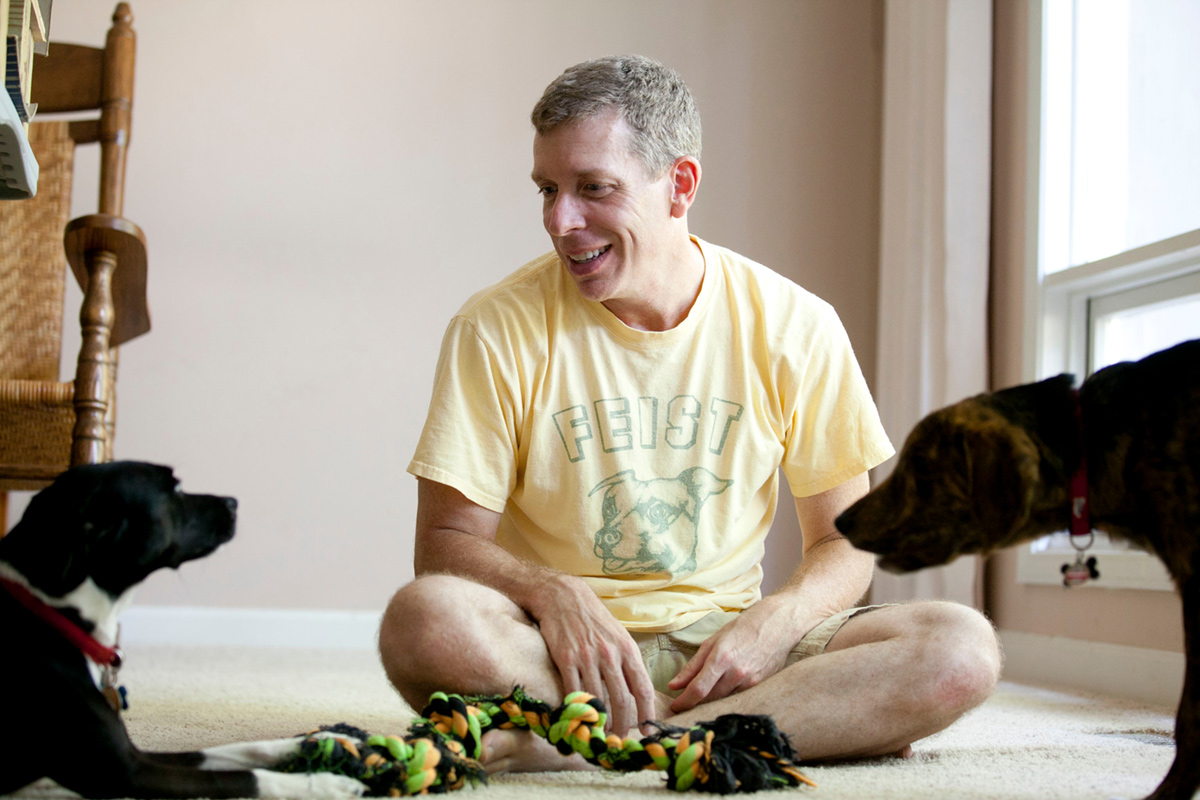
Emory's Greg Berns with his dogs, Callie and Cato.
Bryan Meltz
That’s one of the questions that Berns, Distinguished Professor of Neuroeconomics, hoped to answer with the Dog Project, a groundbreaking research study that produced the first fMRI images of a dog’s brain.
A series of events in Berns’s personal life—including the death of a beloved dog and the arrival of a new one, a party where his two dogs made trouble, and the striking knowledge that a dog was a member of the Navy SEAL team that killed Osama bin Laden—gradually led Berns to wonder about dogs’ minds. What drives their behavior? Do they act on animal instinct, or something more akin to human feeling?
Brain imaging has been a constant in Berns’s varied research, which has explored decision making, motivation, and other cognitive processes in humans. The watershed moment for the Dog Project came when he realized that if a military dog can jump out of a helicopter, dogs could almost certainly be trained to enter an MRI machine. By “mapping” between the brain scans of dogs and humans—a process called functional homology—researchers could potentially throw open a window into the canine mind and revolutionize our understanding of how dogs think.
“Philosophers dismiss the question of what it is like to be a dog as unanswerable, but functional homologies between dog and human brains could provide the missing link,” Berns says. “If we could map our thoughts and feelings onto the dog brain, we could get right to the heart of the dog-human relationship: Do dogs love us?”
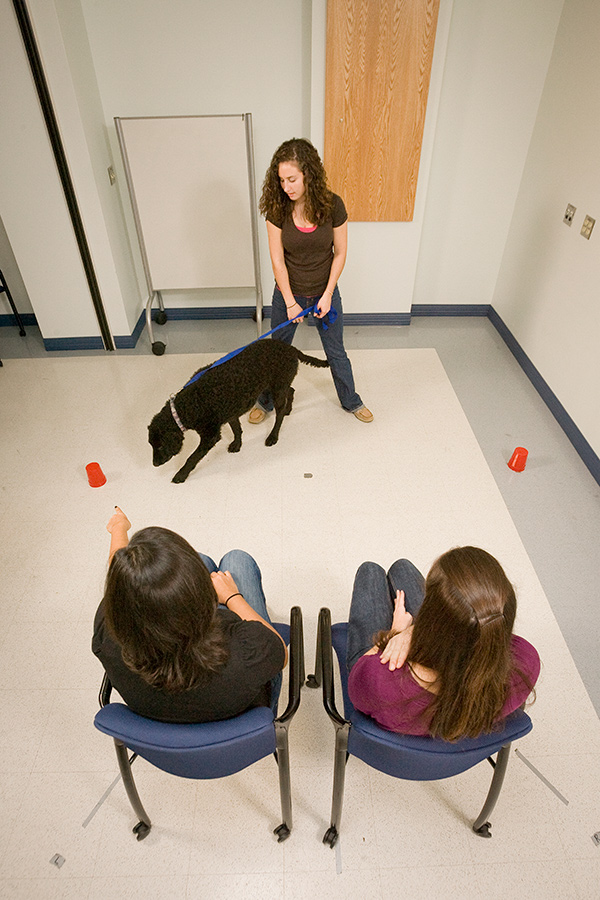
Research assistants work—or play—with a dog in the Duke Canine Cognition Center.
Chris Hildreth/Duke University
Let’s Go Find Out
If you walk around to the back of the Biological Sciences Building at Duke University, you’ll find a set of concrete steps leading up to a flat, empty loading dock and an unassuming metal door marked by a modest blue sign: Canine Cognition Center.
The door opens to a two-room laboratory—one equipped with a few computers, the other with some basic dog-training equipment, containers of treats, and cameras for observation.
The rather spare digs seem incongruous with the ambitious work that’s taking place here in the Duke Canine Cognition Center, founded by Brian Hare 98C. But five minutes with Hare, associate professor of evolutionary anthropology, will tell you that physical space is not really where he lives; it’s in the lavishly equipped rooms of his mind.
While Berns’s ongoing Dog Project has received national attention, it’s not the first time dogs have been studied at Emory. As an undergraduate in the 1990s, Hare led and published a study showing that dogs can follow a human hand pointing—something that chimpanzees, longtime stars of cognitive research, were much less capable of doing.
It all started when Hare didn’t make the baseball team.
An Atlanta native, Hare attended the Lovett School, where he claims he was “not a particularly good student.” But he did get the chance to intern at Zoo Atlanta, working with drills, baboon-like primates who evolved to have dramatically colorful rear ends so their companions could follow them in the jungle.
So when he arrived at Emory (which his mother and uncle also attended), “I was already really excited about animal behavior and studying primates,” Hare says.
He was also really excited about baseball—what he calls his first love. When he wasn’t allowed to try out for the Emory team because he was three minutes late to practice, it was a crushing blow.
“But it was actually the hugest favor anyone ever did for me,” Hare says. “Because it gave me a year to think about it, and meanwhile I took classes with professors like Frans de Waal and discovered that I really loved psychology and evolutionary anthropology and studying primate behavior and cognition. I was hooked.”

Brian Hare with his dog, Tasmania.
Nick Pironio
In his sophomore year, Hare met Michael Tomasello, then a professor of psychology. That connection was a game changer. Tomasello immediately recognized Hare’s spark, and kindled it by encouraging him to participate in serious research. Hare was blown away.
“We had one conversation, and he said, here’s an idea we’ve been thinking about for a research project. What do you think?” Hare says. “And I was like, what? Did he just ask me what I think? This is the coolest guy I have ever met in my life. Right from the beginning, I was part of the team.”
At the same time, Hare had a choice to make about another team—the Emory baseball team, which was holding fall tryouts again.
“I was this eighteen-, nineteen-year-old, starting to realize what science is really all about,” he says. “I was like, wait, you want to study animals to better understand people? I didn’t even know people did that. I had a new love. So the calculation was this—I could try out for baseball, maybe sit on the bench, or I could work with Mike Tomasello and do what I actually thought might be my dream. I could play science like I thought I was going to play baseball. So that’s what I did. I played science like other people play sports.”
Hare continued to work with Tomasello and others, making substantial contributions to various research projects involving primates and eventually receiving credit on some half-dozen scientific publications as an undergraduate—an accomplishment that Tomasello, who now heads the department of developmental and comparative psychology at the Max Planck Institute for Evolutionary Anthropology in Leipzig, Germany, would later call unprecedented.
But Hare’s next breakthrough moment came when he started studying dogs.
At the time, Tomasello was working with some of humans’ closest relatives, chimpanzees, looking specifically at their understanding of communication through gestures. Hare helped him determine that despite their considerable cognitive sophistication, chimpanzees are not so good at something that people can do very early in life: following a pointed finger or a gaze directed at an object of interest. The theory, Hare explains, was that this aspect of social development—shared attention—is key to what makes humans human and distinct from other species.
In his book The Genius of Dogs, Hare describes the conversation with Tomasello in which Hare’s dog, a black lab named Oreo, suddenly became a lot more than his goofy, loyal, slobbery childhood companion. Oreo became the subject of a serious scientific question. As Tomasello and Hare discussed what Hare calls this critical “hole in the cognitive toolkit” of chimps, Hare had a nagging memory of Oreo—following with his eyes as his boy pointed to an errant tennis ball.
“So Mike really thought he had nailed it, this thing that makes us uniquely human,” Hare said in a recent interview at his Duke University office. “And my response was, I think my dog can do that. I had seen him follow my gesture a million times.”
In that moment, Hare says, he learned two incredibly important things. One was that science always begins with a good observation. And two, if you’re a good scientist—a scientist driven by genuine curiosity and the desire to discover, rather than ambition and ego—then it’s okay to be wrong.
Because, without hesitation, Tomasello responded by suggesting that Hare’s assertion should be tested.
“So here’s this brilliant guy who’s been working on this idea for fifteen years, and he’s confronted with this dopey undergraduate who just happens to have a dog that plays fetch with tennis balls. And he’s immediately like, okay, well, maybe I’m wrong. Let’s go find out,” Hare says. “And that’s science. You have an idea, and you are willing to have it falsified. That’s what differentiates science from everything else. If you ask me the number one gift I got from Emory, that’s it right there.”
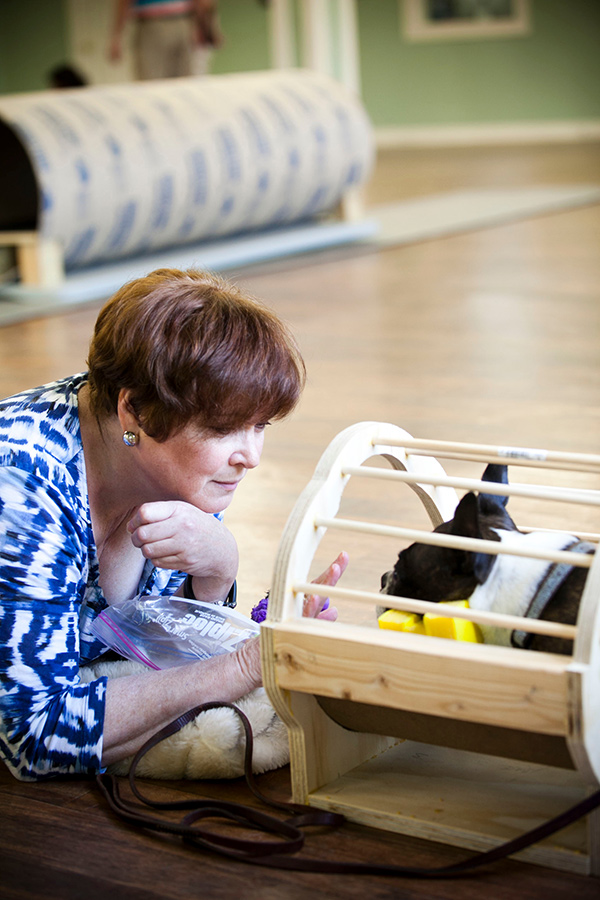
Tigger, a Boston terrier, practices with his owner in the MRI cradle simulator.
Bryan Meltz
Playing Science
It’s Sunday afternoon, and Caylin, a bright-eyed border collie, is straining at the end of her leash as she enters the training lab, tail lashing, eager to get to work.
Not that Caylin views the training as work. For her, these biweekly sessions at the Comprehensive Pet Therapy (CPT) facility in Sandy Springs are a grand adventure in quality interaction with her owner, Lorrie Backer—performing tasks, getting treats and praise, and best of all, basking in Backer’s undivided attention.
Gregory Berns greets Caylin, and all the dogs at today’s practice, with familiar affection: “Pearl, I haven’t seen you in what seems like forever!” he gushes to a grinning golden retriever, who happily nuzzles his hand in response.
These are six of twenty-five dogs currently in the Dog Project program, eighteen of whom are “MRI-certified”—meaning they have proven that they can undergo the fMRI process while both alert enough to produce meaningful results and calm enough to produce reasonably clear images.
That’s what the long hours of practice, orchestrated by professional dog trainer and CPT founder Mark Spivak, are all about. To undergo fMRI, the dogs must be able to place their heads in a cradle and hold still, while responding to hand signals and commands from their owners.
Today they are practicing self-control, resting their furry chins in specially constructed wooden cradle simulators and, ideally, remaining perfectly motionless until a short whistle from their owner tells them to thrust forward and touch a target with their nose. When they’re successful, treats and praise ensue.
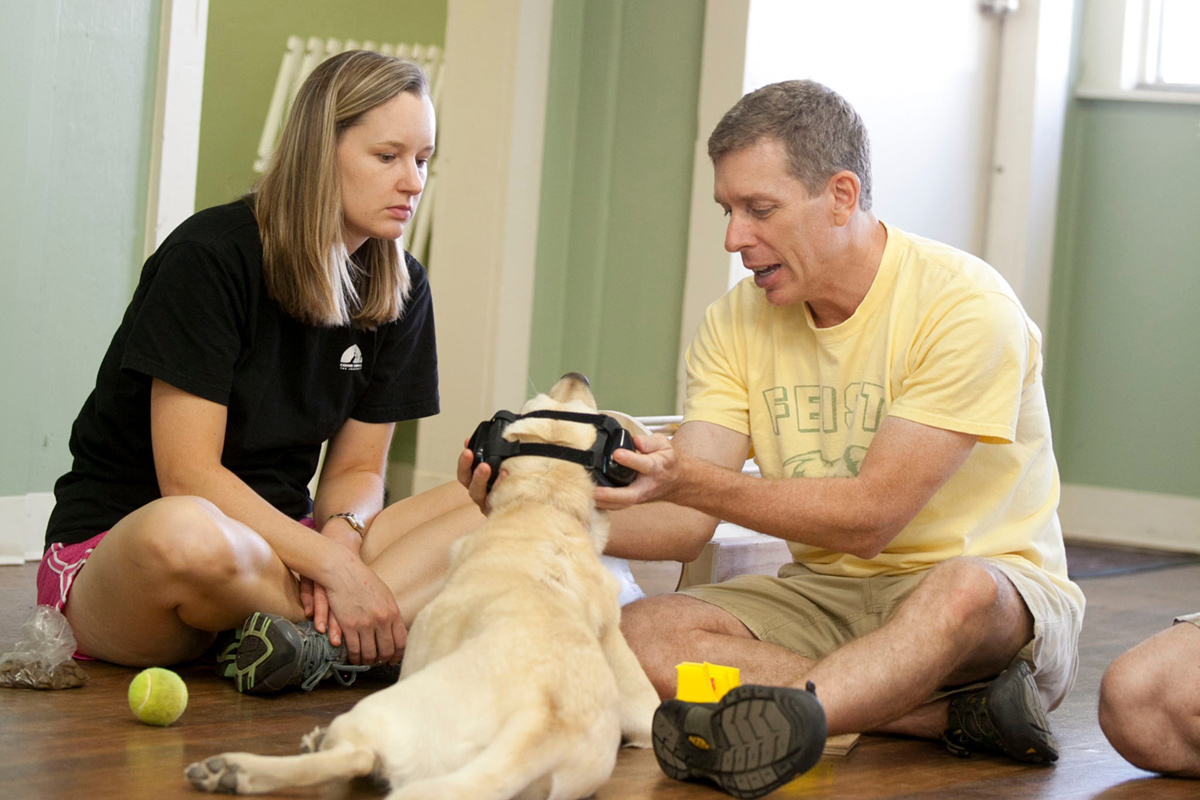
Dogs trained for fMRI—like Zen, above—must be comfortable wearing earmuffs and tolerating noise.
Patient Pearl aces this exercise, while Caylin struggles to contain her natural ebullience, hitting the target too soon. But the action is not the part of the experiment that’s most interesting, Berns explains—it’s the seconds of stillness that tick by before the whistle.
“What we’re trying to understand is the parts of the brain that come online to inhibit behavior,” he says. “Impulse control is very, very hard for dogs, and it takes a great deal of mental energy. They don’t have much of a frontal cortex, which is where self-control lives in humans. But impulsivity is often what gets dogs in trouble. This is all really about understanding them.”
Most of these dogs have already undergone brain imaging. Seeing a picture of their dogs’ brains—which are among the first images of their kind—is the primary reward for the owners, who volunteer their dogs and their time for the Dog Project.
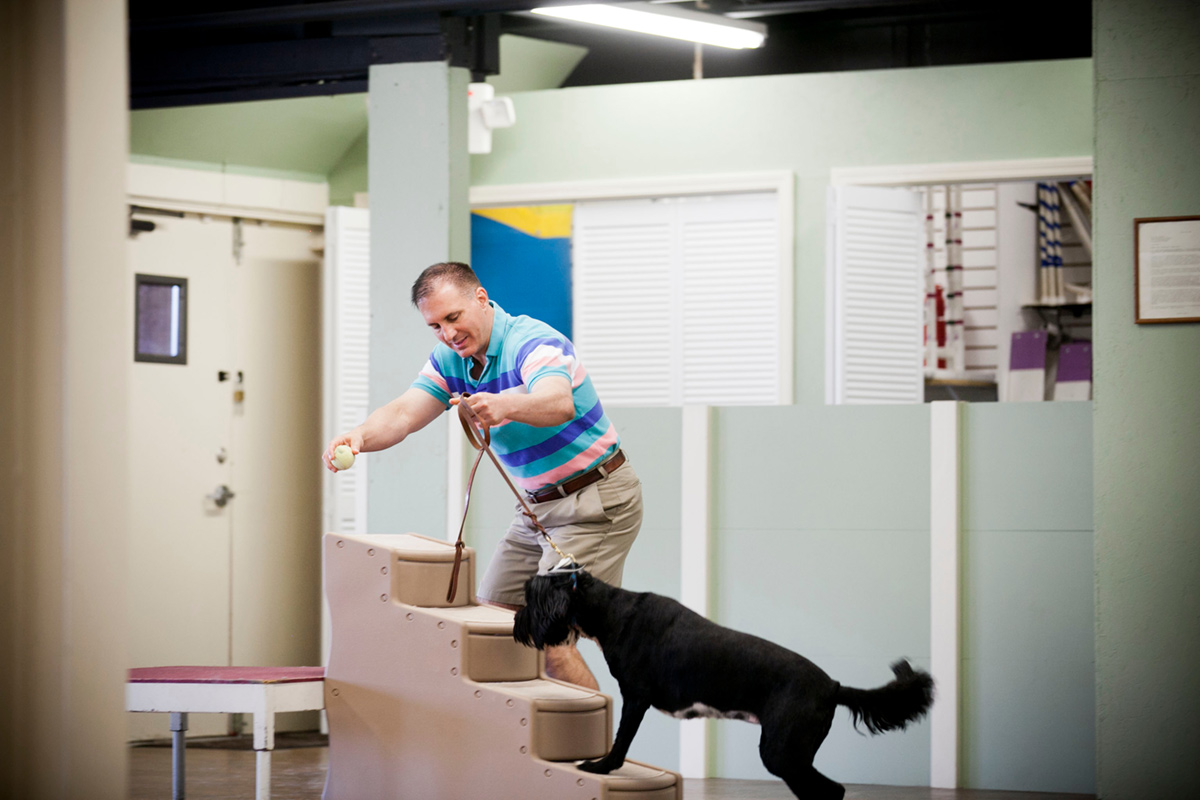
Professional trainer Mark Spivak encourages a dog to mount stairs—about the height of an MRI machine.
Bryan Meltz
“I find the research exciting,” says Pearl’s owner, Vicki D’Amico. “I believe in it, and I’m eager to see where it can go. It’s fascinating to understand my dogs better. Plus, Pearl enjoys it.”
That’s one of the cardinal rules of the Dog Project: Not only are the dogs completely unharmed, they should be having fun. “From the beginning, we agreed that training should be done strictly with positive reinforcement,” Berns writes in How Dogs Love Us. “Everything in the Dog Project should be fun. Fun for the dogs and fun for the owners.”
The first dog in the world to have her brain scanned was Callie, a two-year-old feist (a southern squirrel-hunting dog), whom Berns’s family adopted at nine months old. Callie and McKenzie, a border collie belonging to CPT trainer Melissa Cate, made history in 2012 by successfully undergoing fMRI.
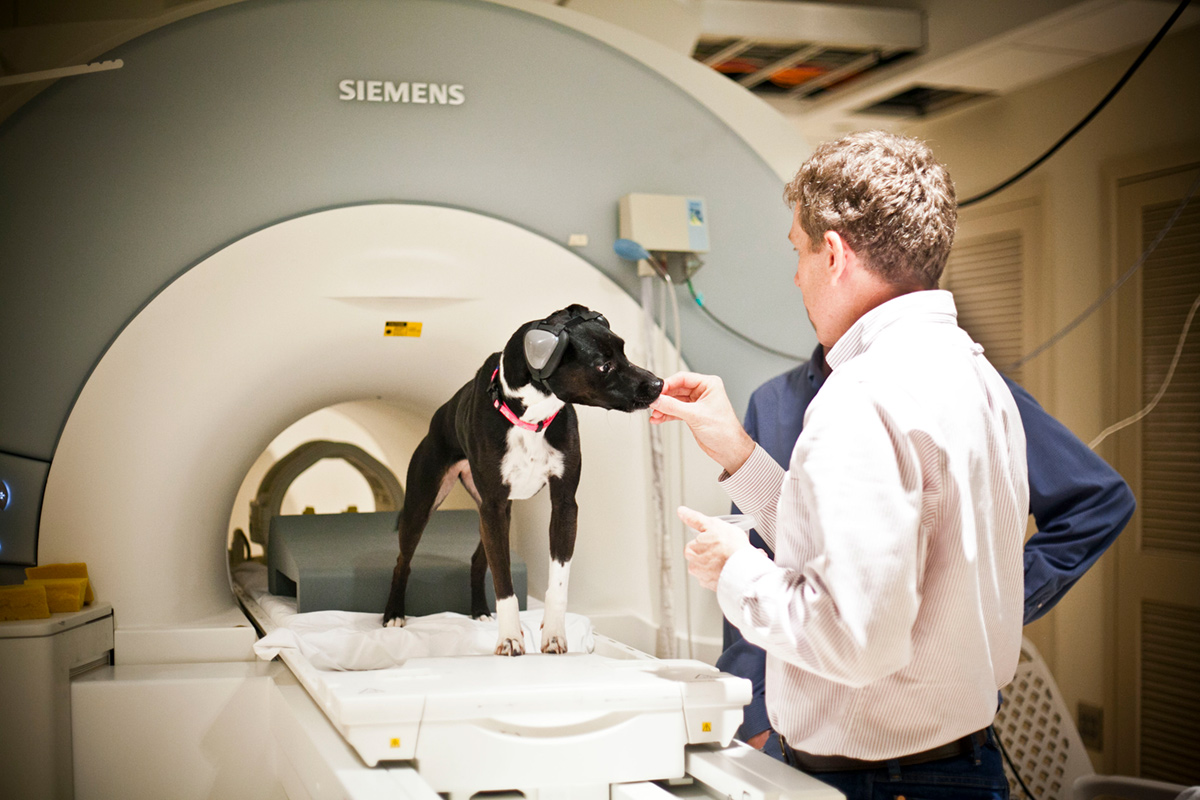
Berns's dog Callie was the first in the world to undergo fMRI while alert and still—a process that demanded time, effort, and patience from dog and humans alike. (Not to mention treats.)
Bryan Meltz
It was a landmark scientific achievement and a major milestone on the road to better understanding how dogs think. But there was a catch.
“It turned out that the dogs’ brains looked nothing like a human’s brain,” Berns writes.
One of the major differences is that dogs have almost no frontal lobe, while humans have the largest frontal lobes of any animal. This is where we perform our most complex cognitive work—processing language, thinking symbolically, planning for the future, and imagining what other people might be thinking. On the other hand, a dog’s olfactory bulb, which processes smell, is gigantic—nearly a tenth of its total brain.
Mapping between the two to draw conclusions about dogs was, Berns admits, a “shaky premise.” So he and graduate student Andrew Brooks decided to begin on the most solid ground they could find: the reward system.
“Unlike the cortex, with its labyrinthine folds, the reward system belongs to the evolutionarily older, reptilian part of the brain,” Berns explains. “The heart of the reward system is the caudate. Because it is so ancient, all mammals have a caudate, and lucky for us, it looks pretty much the same in dogs and humans.”
The team designed an experiment involving hand signals and hot dogs. Eventually, they were able to show that dogs have a positive response in the caudate region of the brain when they are shown a hand signal that promises a piece of hot dog, while a hand signal indicating “no hot dog” elicited no such response.
The key finding was not that dogs like hot dogs; that would hardly be news. What was worth noting was that their reward system was activated in response to a human gesture alone.
“Humans take it for granted that hand gestures convey a great deal of information, almost as much as the eyes,” Berns writes. “Is it possible that dogs place as much importance on hand movements as we do? A growing body of evidence suggests that they do.”
This would have come as no surprise to the character of Edgar Sawtelle, who, inexplicably, never spoke a word in his life. He communicated easily with Almondine using only his hands.
Fun for Dog and Owner
Sisu looks almost bored.
In the lab at the Duke Canine Cognition Center, the sweet-natured two-year-old lab mix is giving a demonstration guided by lab managers and researchers Kerri Rodriguez, a 2011 Duke graduate, and Katelyn Almon. Among other tasks, Sisu is asked to choose which red plastic cup hides a treat placed underneath, follow a pointed gaze and a finger toward food, and infer that the can that rattles when shaken—as opposed to the one that’s silent—is the one that contains something good.
Sisu, who belongs to Evan MacLean, senior research scientist and codirector of the center, is a pro at these training exercises because she’s done them hundreds of times. The tasks are part of a structured program developed by Brian Hare to assess dogs’ cognitive processes and learn about their psychology, the reason the Canine Cognition Center was created in 2009. Dog owners from around the region can sign up to bring their dogs in to be tested; about two hundred “pet dogs” have undergone the assessment, while the researchers have tested many more military and service dogs.
Unbeknownst to the dogs, who likely assume it’s all in good fun, the results of these assessments become part of a database designed to compare cognitive skills and identify patterns that will ultimately shed new light on how dogs think. But with limited space and resources, the center can’t test enough dogs to yield “big data”—the sort of volume that lends credence to scientific study.
“As great as the Canine Cognition Center is, just like any paradigm, there are limits,” says Hare, who also continues to conduct research with primates as head of Duke’s Hominoid Psychology Research Group.
And that’s how Dognition was born.
Hare cofounded the web-based company early last year, partly to be able to exponentially increase his data on dog cognition. Dog owners—anyone, anywhere—can go online, pay $29, and be guided step-by-step through the same series of simple exercises that are performed in the Canine Cognition Center lab. After playing “games” with your pet for twenty minutes a day over five days, the website promises, you’ll “know your dog better.”
The exercises are designed to measure five cognitive skills: empathy, communication, cunning, memory, and reasoning. The results place dogs into one of nine colorful personality profiles with names like maverick, renaissance dog, and socialite. Participants can then enter their data and compare it with all the other dogs tested through Dognition. They can also pay more for a subscription to the site that gives them ongoing access to training tips and research news.
“The goal is to learn a whole lot more about dogs and answer a lot of really cool questions,” says Hare. “It’s also to help people learn things about their own dogs that they can use to improve their relationship with the dog. But what gets me really excited about it is, this is science, but it’s not rocket science. It’s accessible and fun. Let’s introduce science in a way that’s exciting, and I don’t know a better way than with something that’s really meaningful in the family, like a dog.”
It’s easy to assume that Dognition is a measure of dogs’ raw intelligence, but Hare is quick to refute that notion. “The way we conceptualize intelligence today is, you either have it or you don’t,” he says. “The message of Dognition is that there are multiple types of intelligence, and what you can measure are the strategies your dog uses to demonstrate his particular type. Well, you know what? That applies to people, too.”
Puppy Love
Of course, what most of us really want to know is whether we are as special to our dogs as they are to us. Both Hare and Berns have found ways to test whether dogs love us—or at least, whether they respond more strongly to their owners than to strangers.
In the second phase of the Dog Project, Berns performed brain scans on twelve different dogs to assess their response to biological odors—specifically, the sweat of their owners and that of strangers. And guess what? The caudate region, that associated with reward, reacted most strongly to the scent of the familiar human.
“It’s one thing when you come home and your dog sees you and jumps on you and licks you and knows that good things are about to happen,” Berns says. “In our experiment, however, the scent donors were not physically present. That means the canine brain responses were being triggered by something distant in space and time. It shows that dogs’ brains have these mental representations of us that persist when we’re not there.”
And at the Duke Canine Cognition Center, dogs have been tested to see if they will take a treat from their owner more readily than from a stranger—and even whether they will howl along with their familiar person more willingly.
“Dogs show an affiliation toward humans that is unlike any other in the animal kingdom,” Hare writes in The Genius of Dogs. “They prefer humans to their own species and can behave like human infants toward their parents.”
The psychological benefits of dog-human interaction are well documented; that’s part of the reason why Emory offers “dog days” during final exam time, when stressed-out students can take a break and play with therapy dogs. Both the Dog Project and Dognition have major implications for the roles dogs play in our lives, not only as beloved pets but also as useful partners. Many of the dogs tested have been trained as therapy and service dogs through programs such as Canine Companions for Independence. The more we learn about dogs, the scientists say, the more we can enrich our relationships with them.
“The dog’s brain represents something special about how humans and animals came together,” Berns says. “It’s possible that dogs have even affected human evolution. People who took dogs into their homes and villages may have had certain advantages. As much as we made dogs, I think dogs probably made some part of us, too.”
Our young friend Edgar Sawtelle would not disagree. Late in the novel, far from home, he is remembering his Almondine, who has now grown old.
“But what she’d lost in agility she’d gained in perception—in her capacity to peer into him,” Wroblewski writes. “How had he forgotten that? How had he forgotten that in the months after his father’s death, she alone could console him, nosing him at precisely the instant to break some spiral of despair? How had he forgotten that some days she’d saved him by simply leaning against him?”
A work of fiction, yes; but those of us who love dogs recognize its truth.



